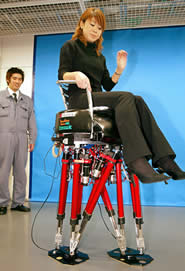The creators of the robot from Waseda University in Tokyo and the Japanese robotics company tmsuk hope that their two-legged creation will one day enable wheelchair users to go up and down stairs and also help move heavy goods on uneven surfaces.
Kleist Beaver, "New Scientist" (translation: Dikla Oren)

Direct link to this page: https://www.hayadan.org.il/caryingrobot.html
The first walking robot capable of carrying a human was unveiled on Friday in Tokyo, Japan.
Its creators from Waseda University in Tokyo and the Japanese robotics company tmsuk hope that their two-legged creation will one day allow wheelchair users to go up and down stairs and also help move heavy goods on uneven surfaces.
The battery-powered robot, known as the WL-16, is essentially an aluminum seat mounted on two sets of adjustable rods. The rods are screwed to two flat plates, which serve as feet.
The 16-WL uses 12 actuators to move forward, backward and sideways while carrying a person, weighing up to 60 kilograms (130 pounds). The robot can adjust its posture and walk smoothly, even if the person sitting in the chair changes their sitting position. It is currently only able to step up or down a few millimeters, but the team plans to modify it so it can handle a standard staircase.
"I believe that this bipedal robot, which I prefer to call a walking chair rather than a wheelchair, will eventually allow people to go up and down stairs," said Atsuo Technishi from Waseda University.
"We've had powerful robots for some time, but they've usually been manipulators, they haven't been adapted to carry people," said Ron Arkin of the Georgia Institute of Technology, a robotics consultant for Sony. "But I don't know how safe and user-friendly the 16-WL is."
Tamsuk's deputy director, Yoichi Takamoto, claims that bipedal or multi-legged robots will be more efficient than the "caterpillar" model in moving over non-planar terrain.
The normal stride length of the 16-WL is 30 centimeters, but it can spread its legs up to a distance of 136 centimeters. The prototype is currently operated by radio, but the research team plans to equip it with a joystick-like controller in the future, Technishi said. It will take another two years to develop the working model prototype.
Smaller robots have been developed to tackle tricky areas. One worm-like robot uses a magnetic fluid to move forward, while another snake-like robot uses smart software to plan new movement strategies if the surface destroys one of its parts.
One spherical robot uses the "jump-and-skip" method to move in a cut-off area. However, none of the above is strong enough to carry a person.
